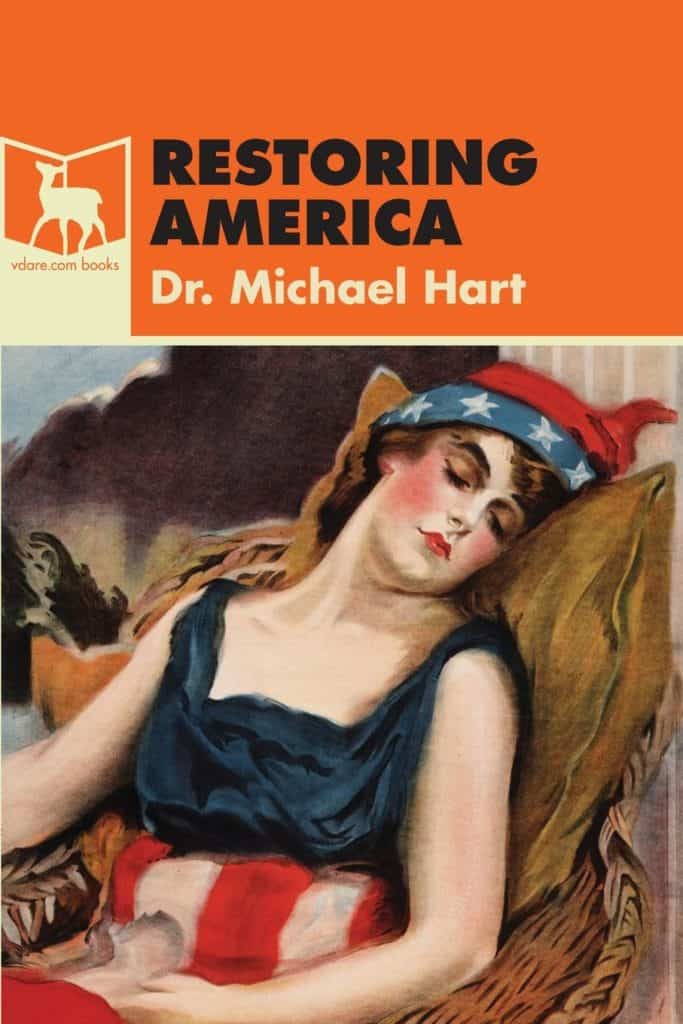What Can Be Done About Political Polarization?
Michael Hart, American Renaissance, June 28, 2017
Many people have written about the extreme political polarization in the United States today. However, few people have suggested any way to end it — or at least reduce it to normal, manageable levels — other than saying that the other side should be more reasonable. On this subject, there are three questions we should consider:
- How extreme is the political polarization today?
- If it is worse than in the past, why did it become so bad?
- What, if anything, can be done to end it?
How extreme is today’s political polarization?
Angry feelings between “liberals” and “conservatives” or between Democrats and Republicans have always been commonplace, but there have been periods when they were more intense than usual. Two such periods were the Vietnam War (roughly 1960-1975) and the McCarthy era (roughly 1950-1954).
I lived through both periods, and it seems to me that polarization is more extreme today. I have asked others who lived through those times, and they agree that divisions have never been sharper.
In 1952, at the height of McCarthy era, a Republican Dwight Eisenhower was elected president. Those who had supported his Democratic opponent, Adlai Stevenson of Illinois, were disappointed, but they accepted the results without protest. In contrast, when Donald Trump won the general election there were immediate calls for members of the Electoral College to ignore the will of the voters and vote against him. The addresses of various electors were printed, together with physical threats against them; no prominent Democratic politician publicly denounced these threats. Calls for Donald Trump to be impeached started shortly after the election, even before he had taken office.
The protests against the Vietnam War were both intense and widespread. However, there were never open suggestions that the presidents prosecuting the war should be assassinated. Yet recently, a prominent TV “humorist” posted an image of herself holding up President Trump’s severed head. Kathy Griffin is hardly alone. Madonna, Snoop Dogg, and Robert De Niro are among at least a dozen leftist celebrities who have fantasized about killing or attacking the President.

Kathy Griffin
A production in New York City of Shakespeare’s play Julius Caesar includes an actor dressed as Donald Trump being stabbed to death — as the audiences applauds enthusiastically. I have attended various productions of that play, and there was never any applause when Caesar was assassinated even though Julius Caesar, unlike Donald Trump, had staged a military coup that had overthrown constitutional rule in Rome, and had then taken the title “dictator for life.”
A few weeks ago, a deranged left-winger began shooting Republican congressmen who were practicing for a baseball game. Most people, including leading Democrats, were rightly horrified, but not all. Sonia Gupta, a former prosecutor from Congressman Scalise’s home state of Louisiana, tweeted: “Before you start dropping to your knees to pray for Steve Scalise, remember that he is a racist piece of shit and hateful bigot.” I can recall nothing remotely as venomous when President Ronald Reagan was shot in an assassination attempt in 1981.
As this interactive map shows, there have been hundreds of attacks on Trump supporters since the election. Richard Spencer was sucker-punched by a stranger on inauguration day. Charles Murray was attacked at Middlebury College, and Milo Yiannopoulos and Ann Coulter were prevented from speaking at Berkeley by violence and threats of violence. It is now routine to withdraw invitations from conservative speakers or to shout them down if they try to speak.

Richard Spencer being punched on inauguration day.
Hostility now extends to ordinary people, not just politicians and prominent figures. In 1960, only 4 percent of Democrats and 5 percent of Republicans said they would not like it if a child of theirs married someone from the other party. By 2010, the figures had risen to 33 percent for Democrats and 49 percent for Republicans, and levels of hostility are surely higher today.
What causes extreme polarization?
There seems to be little agreement about what has caused this level of polarization. Economic conditions are not worse than normal. Military casualty rates are not high. Crime rates are not unusually high. Stores are bulging with goods, and people are buying them. Many people are enjoying obvious luxuries such as foreign travel and trips on cruise ships. Life expectancy at birth — a good measure of the general health of the population — is at or near a record high. Racial antagonisms are not clearly worse than they have been in the past.
Liberals and conservatives are badly divided on issues such as abortion, how progressive tax rates should be, and how large transfer payments should be. However, that has always been the case, and such disagreements cannot explain the extraordinary level of political polarization, nor its steady growth.
I would note that the increasing division between the two parties is not due to the Republican Party moving to right, but to the increasingly leftwing march of the Democratic Party. Donald Trump is less conservative than Ronald Reagan was in 1980, and to the left of Dwight Eisenhower in 1952. Compare, for example, their stands on immigration, school integration, abortion, or gay rights. However, the policies of the Democratic Party have altered greatly since 1952. Compare, for example, its current positions on free speech, abortion, and racial quotas with the views of Hubert Humphrey, Adlai Stevenson, and John F. Kennedy.
I would like to make two suggestions as to the possible causes of extreme and growing polarization. They are not mutually exclusive, and both may play a role.
First, I believe loss of faith in our country — most evident among the college educated — is a result of a slow, long term decline in religious belief. A belief in Christianity was the glue that held our country together through earlier difficulties. As that faith wanes, our divisions become harder to bridge. Note that Edward Gibbon, in The Decline and Fall of the Roman Empire, suggested that loss of faith in the old Roman religion was a major factor in the fall of Rome.
By this I am not suggesting that Jews are naturally unpatriotic because they are not Christians. The theological differences between religious Jews and religious Christians are minor compared with the differences between believers and non-believers, and orthodox Jews tend to be politically conservative. There are also many who are not religious but who still love and honor the United States, but this is not necessarily true of many atheists and agnostics.
Second, during the Vietnam War, many young people — particularly college students — lost their faith in the essential goodness of the United States. Instead, they came to think of this country as basically imperialist and racist — a force for evil. In the course of time, these radicalized students became professors, and large numbers of their students have been propagandized to accept similar views. The result is polarization, which is particularly marked among the college educated.
If these explanations for our current high level of political polarization are correct, we cannot expect tensions to subside any time soon.
What can we do?
There are several alternatives.
- Try to cooperate with Democrats to reduce hostilities
- Do nothing, and hope that polarization will go away, or at least not get worse
- Try to crush our opponents militarily
- Work for a peaceful partition of the country
Cooperation with Democrats sounds reasonable, and I have no objection to trying it, but I don’t think it will succeed. Most of the leaders of the Democratic Party are not interested in reducing ill will, but prefer to increase suspicion and hatred of the other party. They have been charging Trump with stealing the election, and have been calling for impeachment. Some of them even claim that impeachment is not enough, and that he should be tried for treason and executed! They constantly call Mr. Trump a fascist and compare him to Hitler, which suggests that his assassination would be acceptable, and even praiseworthy.
Doing nothing and hoping for the best will not accomplish anything. A continuation of the present situation is just what we want to avoid; it is clearly unstable. Wishful thinking has never been a sound policy.
The last time polarization was high as it is today, the result was civil war. Abraham Lincoln crushed his opposition militarily, at a cost of about 1.5 percent of the population (that would be over four million dead today). We must avoid a civil war if at all possible.
I think the best way to deal with extreme polarization is to break up the United States into separate countries. In one of them, Democrats and left-wing voters would be in the majority. In another, Republicans and conservatives would be the majority. Within each country there would be far less polarization than there is now in the United States.
This is obviously a drastic step, and many people shrink from even considering it. However, there are many instances of countries being partitioned successfully, and in the great majority of cases, partition worked out for the best.
- Norway split from Sweden in 1905
- Singapore split from Malaysia in 1965
- Bangladesh split from Pakistan in 1971
- Cyprus was divided into a Greek part and a Turkish part in 1974
- The Soviet Union broke into 15 separate nations in 1990-1991
- Yugoslavia broke into seven independent nations in the early 1990s
- Czechoslovakia split in two in 1993
I have written a book, Restoring America that describes how the United States might be successfully partitioned. It answers such questions as: How would boundaries be determined? What would happen to liberals living in a conservative area and vice versa? What political procedures would be needed for the breakup? How would the armed forces be divided?
The current state of polarization is not sustainable. We should begin thinking now about realistic, humane ways to defuse tensions that are likely only to get worse.
















